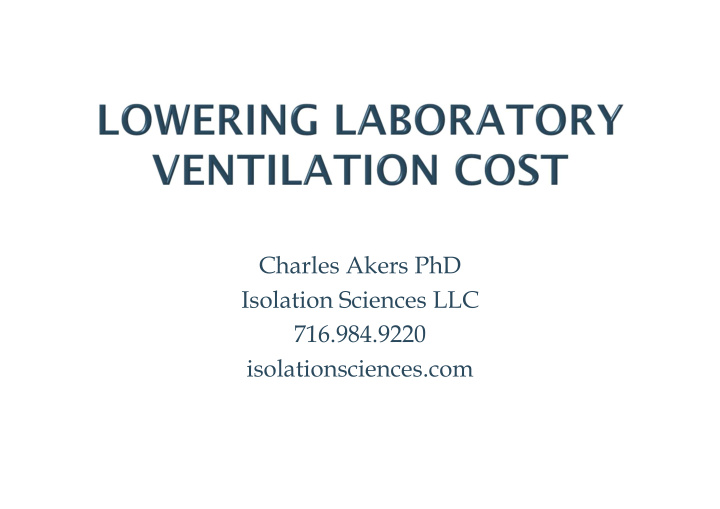



Charles Akers PhD Isolation Sciences LLC 716.984.9220 isolationsciences.com
2 Cooling 23% 23% Plug Lighting 11% 44% Ventilation REF: Louis Stokes Research Laboratory [NIH, Bethesda, MD]
Fume hoods waste in the US over $5B annually or each fume hood wastes enough energy to heat 3-4 homes and fume hoods lowers the laboratory IAQ
Room Air Dynamics forming Eddy Currents Spills and Splashes Energetic Events blown out of fume hood
FEATURES � Fits under the sash � Clear PU barrier film � Movable Access Ports
Sash Open 691 cfm Sash Closed with CAP 120 cfm 570 cfm Reduction in Exhausted Air Test Condition: 6 ft fume hood Working sash height = 18inches Minimum Air flow = ANSIZ9.5-2010
Min Max Mean Left 0.00 0.02 0.006 Center 0.00 0.02 0.002 Right 0.00 0.01 0.001 [ppm] Site: Buffalo Niagara Medical Campus Innovation Center Tester: Air Filtration Management Test Conditions: [3 rd party NEEB Certified] ASHRAE-110 Min level 0.100ppm SF6 rate = 8 liters/min
Klein RC, King C, and Kosior A, Journal of Chemical Health and Safety, 16(2009)36-42
Laboratory Ventilation Rates • Control banding: classify lab hazard • New standard defines Hazard Level A,B, & C • Occupied versus unoccupied vent rates • Setback control strategy by lab’s hazard classification • Unoccupied air change rate reduced by 2ACH • Results… • Lab ‘A’ 8/6 ACH • Lab ‘B’ 6/4 ACH • Lab ‘C’ 4/2 ACH Source: Bell, G, Optimizing laboratory Ventilation Rates, Labs21 Advance Course Series, 2010
A Triple Benefit to Your Bottom Line • Reduces Energy Costs • Reduces Carbon Footprint • Reduces Safety Risk
Chuck Akers Isolation Sciences 716-984-9220 cakers@isolationsciences.com Isolationsciences.com 13
Recommend
More recommend